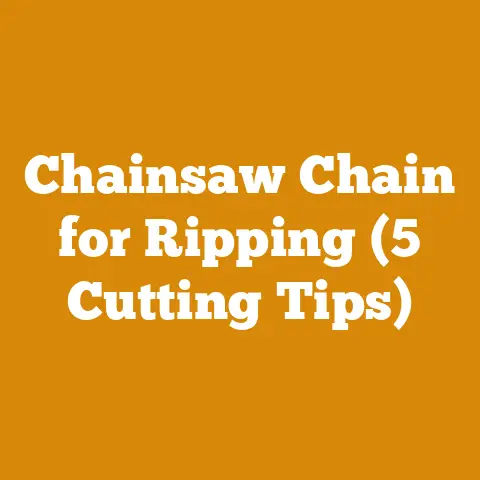What to Do If Chain Comes Off Chainsaw (3 Quick Fixes)
The Chainsaw: A Trendsetter’s Tool
Chainsaws are not just for lumberjacks or professional woodworkers; they’ve become essential tools for homeowners, gardeners, and DIY enthusiasts.
Their versatility and power make them a trendsetter’s choice – a must-have in any tool collection.
But what happens when the chain comes off?
Let’s explore the ins and outs of handling this common issue.
The Anatomy of a Chainsaw
Understanding the parts of your chainsaw is essential for proper maintenance and repair.
Here’s a quick rundown:
- Engine: Powers the chainsaw, available in gas or electric.
- Guide Bar: The metal bar guiding the chain.
- Chain: The cutting component.
- Sprocket: Transfers power from the engine to the chain.
- Tensioning Screw: Adjusts the chain tension on the guide bar.
- Handles: For controlling the chainsaw safely.
Why Chains Come Off: Digging Deeper
Let’s delve into the reasons why chains may come off the chainsaw and how understanding these can prevent future problems.
1. Loose Tension
Chains naturally loosen over time.
Each time you use your chainsaw, vibrations cause the chain to stretch.
Checking and adjusting the tension regularly is crucial.
2. Worn Out Parts
Components like the sprocket and guide bar wear out with use.
Regular inspection can help identify when parts need replacement.
3. Improper Installation
Even experienced users can occasionally install a chain incorrectly.
Ensuring it’s properly seated on both the sprocket and guide bar is vital.
In-Depth Fixes for a Loose Chain
Now let’s expand on our quick fixes with more detailed instructions and insights.
Fix 1: Mastering Chain Tension
A proper chain tension not only prevents it from coming off but also enhances performance and safety.
Tools Needed: Chainsaw wrench, protective gloves
Step-by-Step Guide:
- Ensure Safety: Always turn off the chainsaw and let it cool.
- Assess Tension:
- Hold the chain at the midpoint of the bar.
- It should snap back into place without sagging.
- Adjust Tension:
- Locate the tensioning screw (often near the side panel).
- Use the wrench to adjust until you achieve optimal tension.
- Test It:
- Rotate the chain by hand (wear gloves).
- It should move smoothly with slight resistance.
- Recheck After Use:
- Chains can loosen after initial adjustments; recheck after a short period of use.
Fix 2: Proper Reinstallation Techniques
If tightening doesn’t work, reinstalling might be necessary.
Tools Needed: Protective gloves, chainsaw wrench
Detailed Steps:
- Safety First:
- Wear gloves to protect against sharp edges.
- Ensure the chainsaw is off and cooled down.
- Remove Side Panel:
- Loosen and remove the nuts securing the side panel.
- Carefully lift it away to expose the chain and sprocket.
- Remove and Inspect Chain:
- Slide the chain off the guide bar.
- Inspect for damage or wear; replace if necessary.
- Reinstall Chain Correctly:
- Place it over the sprocket first.
- Align it along the guide bar grooves, ensuring it’s seated properly.
- Reattach Side Panel:
- Position it back and secure with nuts.
- Don’t fully tighten until you’ve adjusted tension.
- Final Adjustments:
- Use the tensioning screw to fine-tune tension.
- Ensure everything feels secure before use.
Fix 3: Identifying and Replacing Worn Parts
Sometimes, persistent issues indicate worn components that need replacement.
Tools Needed: Screwdriver, replacement parts (guide bar, sprocket)
- Prepare Chainsaw:
- Turn off and allow it to cool.
- Remove side panel as described in Fix 2.
- Inspect Guide Bar and Sprocket:
- Look for uneven wear, nicks, or dents.
- Check alignment with a straightedge tool.
- Replace Worn Parts:
- Follow manufacturer’s guidelines for installation.
- Ensure new parts are correctly aligned and secured.
- Reassemble Chainsaw:
- Install chain as per previous instructions.
- Reattach all components securely.
- Conduct a Test Run:
- Start chainsaw in a safe area.
- Observe chain operation; adjust if necessary.
Safety Precautions Revisited
Chainsaws are powerful tools, and safety cannot be overstated.
Let’s delve deeper into critical safety practices.
Personal Protective Equipment (PPE)
- Helmet with Visor: Protects head and eyes from debris.
- Hearing Protection: Chainsaws are loud; protect your ears with earmuffs or plugs.
- Cut-resistant Gloves: Essential for hand protection.
- Chainsaw Chaps or Pants: Protect legs from accidental contact.
- Boots with Steel Toes: Prevent foot injuries.
Safe Operating Practices
- Clear Work Area: Ensure no one is nearby when operating the chainsaw.
- Firm Grip and Stance: Maintain control with both hands on handles.
- Avoid Kickback Zone: Be aware of potential kickback areas; work outside this zone.
- Regular Breaks: Avoid fatigue by taking regular breaks during extended use.
Deep Dive into Troubleshooting
Having trouble with your chainsaw beyond a loose chain?
Here are additional troubleshooting tips to keep your tool functioning at its best.
Common Issues and Solutions
- Chainsaw Won’t Start
- Check fuel levels or battery charge.
- Inspect spark plug for wear or damage.
- Chain Cuts Poorly
- Sharpen chain regularly using appropriate tools.
- Ensure chain teeth are aligned and sharp.
- Excessive Vibration
- Inspect mountings for loose screws or bolts.
- Check for bent or damaged components.
- Overheating
- Clean air filters regularly to ensure airflow.
- Check oil levels; lubricate chain frequently.
Maintenance Best Practices
Keeping your chainsaw in top condition requires regular maintenance beyond just fixing a loose chain.
Regular Maintenance Tasks
- Cleaning
- After each use, clean debris from guide bar and sprocket.
- Use compressed air to blow out dust from motor vents.
- Lubrication
- Regularly oil the chain to reduce friction and wear.
- Check oil reservoir levels before each use.
- Sharpening
- Use a round file matching your chain’s pitch.
- Sharpen every few uses to maintain cutting efficiency.
- Storage
- Store in a dry place away from moisture.
- Use a protective cover for the guide bar when not in use.
Advanced Tips for Chainsaw Enthusiasts
For those who want to go beyond basic fixes, here are some tips that can enhance your chainsaw expertise:
- Understand Chain Types
- Different chains suit different tasks (e.g., ripping vs.
cross-cutting). - Choose a chain that matches your specific cutting needs.
- Different chains suit different tasks (e.g., ripping vs.
- Invest in Quality Tools
- High-quality tools last longer and perform better.
- Consider investing in a professional-grade sharpener.
- Join a Community
- Online forums or local clubs offer valuable advice and support.
- Share experiences and learn from fellow enthusiasts.
- Attend Workshops
- Hands-on workshops provide practical learning opportunities.
- Gain insights from experts in the field.
Common Concerns Addressed
Let’s tackle some of the frequent questions people have about chainsaws and their operation:
Why Does My Chainsaw Smoke?
Smoking can indicate improper lubrication or an overly rich fuel mix.
Check oil levels and mix ratios as per manufacturer recommendations.
How Often Should I Replace My Chain?
Chains should be replaced when they become too worn or damaged to sharpen effectively.
Regular inspection helps determine when replacement is necessary.
Is It Normal for My Chainsaw to Leak Oil?
Some oil leakage is normal due to gravity-feed systems, but excessive leaking may indicate a problem with seals or gaskets that need attention.
Conclusion: Mastering Your Chainsaw
Mastering your chainsaw means more than just knowing how to fix a loose chain; it involves understanding how it works, maintaining it properly, and using it safely and efficiently.
By following these in-depth guides and tips, you’ll become not just proficient but truly skilled in managing your tool.
FAQ Section
Can I Use Vegetable Oil for Chain Lubrication?
While vegetable oil can be used in emergencies due to its lubricating properties, it’s best to use specialized bar oil designed for chainsaws to ensure optimal performance and longevity.
What’s the Best Way to Store My Chainsaw Long-term?
Clean thoroughly, empty fuel tank (for gas models), lubricate chain, and store in a cool, dry place with a protective cover over the guide bar.
How Do I Prevent Kickback?
Ensure proper tension, maintain sharpness of chain teeth, avoid cutting with tip of bar, and use chainsaws equipped with anti-kickback features like chain brakes.






